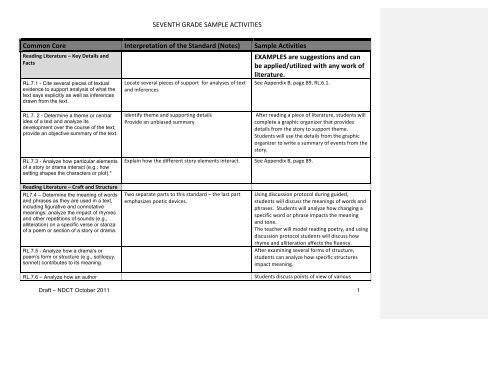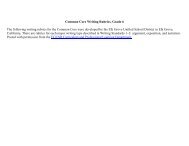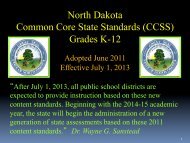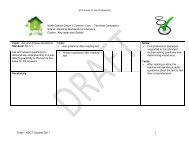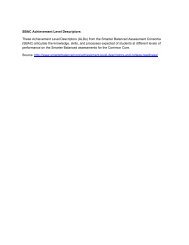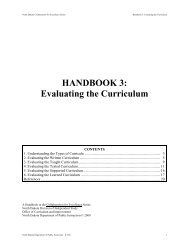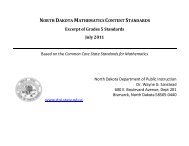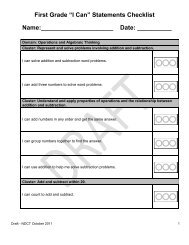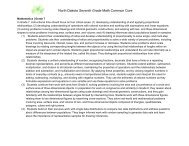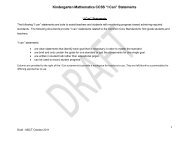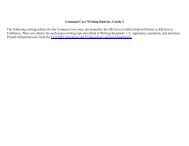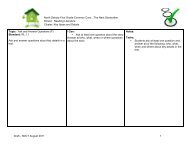SEVENTH GRADE SAMPLE ACTIVITIES Common Core ...
SEVENTH GRADE SAMPLE ACTIVITIES Common Core ...
SEVENTH GRADE SAMPLE ACTIVITIES Common Core ...
Create successful ePaper yourself
Turn your PDF publications into a flip-book with our unique Google optimized e-Paper software.
<strong>SEVENTH</strong> <strong>GRADE</strong> <strong>SAMPLE</strong> <strong>ACTIVITIES</strong> definitions, concrete details,quotations, or other information andexamples.c. Use appropriate transitions to createcohesion and clarify the relationshipsamong ideas and concepts.d. Use precise language and domainspecificvocabulary to inform about orexplain the topic.e. Establish and maintain a formal style.f. Provide a concluding statement orsection that follows from andsupports the information orexplanation presented.W.7.3 - Write narratives to develop realor imagined experiences or events usingeffective technique, relevant descriptivedetails, and well-structured eventsequences.a. Engage and orient the reader byestablishing a context and point ofview and introducing a narratorand/or characters; organize an eventsequence that unfolds naturally andlogically.b. Use narrative techniques, such asdialogue, pacing, and description, todevelop experiences, events, and/orcharacters.c. Use a variety of transition words,phrases, and clauses to conveysequence and signal shifts from onetime frame or setting to another.d. Use precise words and phrases,relevant descriptive details, andsensory language to capture theStudents will write an imaginary story. Draft – NDCT October 2011 6
<strong>SEVENTH</strong> <strong>GRADE</strong> <strong>SAMPLE</strong> <strong>ACTIVITIES</strong> action and convey experiences andevents.e. Provide a conclusion that followsfrom and reflects on the narratedexperiences or events.Writing – Production and Distribution W.7.4 - Produce clear and coherentwriting in which the development,organization, and style are appropriate totask, purpose, and audience. (Gradespecificexpectations for writing types aredefined in standards 1–3.)W.7.5 - With some guidance and supportfrom peers and adults, develop andstrengthen writing as needed byplanning, revising, editing, rewriting, ortrying a new approach, focusing on howwell purpose and audience have beenaddressed. (Editing for conventionsshould demonstrate command ofLanguage standards 1–3 up to andincluding grade 7.)W.7.6 - Use technology, including theInternet, to produce and publish writingand link to and cite sources as well as tointeract and collaborate with others,including linking to and citing sources.Writing – Research to Build andPresent KnowledgeW.7.7 - Conduct short research projectsto answer a question, drawing on severalsources and generating additionalrelated, focused questions for furtherresearch and investigation.Students will write two versions of a topic for two different audiences. (e.g. Audiences of a teacher and a peer.) Students use feedback of peers and adults to improve writing. Students will publish writings and post them on an interactive website. Students will conduct research on relevant topics and generate additional questions for further investigation. W.7.8 - Gather relevant information from There are six separate parts to this standard. Teachers will model correct procedure for Draft – NDCT October 2011 7
<strong>SEVENTH</strong> <strong>GRADE</strong> <strong>SAMPLE</strong> <strong>ACTIVITIES</strong> multiple print and digital sources, usingsearch terms effectively; assess thecredibility and accuracy of each source;and quote or paraphrase the data andconclusions of others while avoidingplagiarism and following a standardformat for citation.W.7.9 - Draw evidence from literary orinformational texts to support analysis,reflection, and research.a. Apply grade 7 Reading standards toliterature (e.g., "Compare andcontrast a fictional portrayal of a time,place, or character and a historicalaccount of the same period as ameans of understanding how authorsof fiction use or alter history.").b. Apply grade 7 Reading standards toliterary nonfiction (e.g., "Trace andevaluate the argument and specificclaims in a text, assessing whetherthe reasoning is sound and theevidence is sufficient to support theclaims.").Use literary evidence in a written piece. determining and gathering credible information and sources. Students will apply that information. Students will use fiction and nonfiction to support research. Writing – Range of WritingW.7.10 - Write routinely over extendedtime frames (time for research, reflection,and revision) and shorter time frames (asingle sitting or a day or two) for a rangeof discipline-specific tasks, purposes, andaudiences.Students will write continually across disciplines for a variety of purposes. Draft – NDCT October 2011 8
<strong>SEVENTH</strong> <strong>GRADE</strong> <strong>SAMPLE</strong> <strong>ACTIVITIES</strong> <strong>Common</strong> <strong>Core</strong> Interpretation of the Standard (Notes) Sample Activities Speaking and Listening – Comprehension and Collaboration SL.7.1 - Engage effectively in a range ofcollaborative discussions (one-on-one, ingroups, and teacher-led) with diversepartners on grade 7 topics, texts, andissues, building on others’ ideas andexpressing their own clearly.a. Come to discussions prepared,having read or material under study;explicitly draw on that preparation byreferring to evidence on the topic,text, or issue to probe and reflect onideas under discussion.b. Follow rules for collegial discussions,track progress toward specific goalsand deadlines, and define individualroles as needed.c. Pose questions that elicit elaborationand respond to others’ questions andcomments with relevant observationsand ideas that bring the discussionback on topic as needed.d. Acknowledge new informationexpressed by others and, whenwarranted, modify their own views.Using discussion protocol students will use an excerpt from a text and engage in a discussion with a classmate. SL.7.2 - Analyze the main ideas andsupporting details presented in diversemedia and formats (e.g., visually,quantitatively, orally) and explain how theideas clarify a topic, text, or issue understudy.SL.7.3 - Delineate a speaker’s argumentand specific claims, evaluating thesoundness of the reasoning and therelevance and sufficiency of theStudents will analyze diverse media or formats for main ideas and support and explain how they contribute to the understanding of an issue presented. Students will listen to a speaker and using discussion protocol will evaluate and discuss whether the speaker’s claims are supported by Draft – NDCT October 2011 9
<strong>SEVENTH</strong> <strong>GRADE</strong> <strong>SAMPLE</strong> <strong>ACTIVITIES</strong> evidence.Speaking and Listening – Presentation of Knowledge and Ideas SL7.4 - Present claims and findings,emphasizing salient points in a focused,coherent manner with pertinentdescriptions, facts, details, andexamples; use appropriate eye contact,adequate volume, and clearpronunciation.SL7..5 - Include multimedia componentsand visual displays in presentations toclarify claims and findings andemphasize salient points.Teachers will model multimedia components. evidence or not. Students will choose a topic and present claimsfocusing on significant points using appropriatespeaking skills. Students will use multimedia components to clarify significant points. SL.7.6 - Adapt speech to a variety ofcontexts and tasks, demonstratingcommand of formal English whenindicated or appropriate. (See grade 7Language standards 1 and 3 for specificexpectations.)Students will use formal English when giving a presentation on a specific topic to peers or others. Draft – NDCT October 2011 10
<strong>SEVENTH</strong> <strong>GRADE</strong> <strong>SAMPLE</strong> <strong>ACTIVITIES</strong> <strong>Common</strong> <strong>Core</strong> Interpretation of the Standard (Notes) Sample Activities Language – Conventions of Standard English L.7.1 - Demonstrate command of theconventions of standard Englishgrammar and usage when writing orspeaking.*a. Explain the function of phrases andclauses in general and their functionin specific sentences.b. Choose among simple, compound,complex, and compound-complexsentences to signal differingrelationships among ideas.c. Place phrases and clauses within asentence, recognizing and correctingmisplaced and dangling modifiers.Types of sentences and parts of sentences are emphasized but other conventions of grammar should be reviewed. Students will demonstrate the proper usage of grammar through mini-‐lessons, daily writing, and editing focusing on phrases, clauses, and types of sentences. L.7.2 - Demonstrate command of theconventions of standard Englishcapitalization, punctuation, and spellingwhen writing.a. Use a comma to separate coordinateadjectives (e.g., It was a fascinating,enjoyable movie but not He wore anold[,] green shirt).b. Spell correctly.Review all forms of punctuation. Students will demonstrate proper use of capitalization, punctuation, and spelling in any written document. Language – Knowledge of Language L.7.3 - Use knowledge of language andits conventions when writing, speaking,reading, or listening.a. Choose language that expressesideas precisely and concisely,recognizing and eliminatingwordiness and redundancyIn writing students will show command of precise language usage. Draft – NDCT October 2011 11
<strong>SEVENTH</strong> <strong>GRADE</strong> <strong>SAMPLE</strong> <strong>ACTIVITIES</strong> Language – Vocabulary Acquisitionand UseL.7.4 - Determine or clarify the meaningof unknown and multiple-meaning wordsand phrases based on grade 7 readingand content, choosing flexibly from arange of strategies.a. Use context (e.g., the overallmeaning of a sentence or paragraph;a word’s position or function in asentence) as a clue to the meaningof a word or phrase.b. Use common, grade-appropriateGreek or Latin affixes and roots asclues to the meaning of a word (e.g.,belligerent, bellicose, rebel).c. Consult general and specializedreference materials (e.g.,dictionaries, glossaries,thesauruses), both print and digital,to find the pronunciation of a word ordetermine or clarify its precisemeaning or its part of speech.d. Verify the preliminary determinationof the meaning of a word or phrase(e.g., by checking the inferredmeaning in context or in a dictionary).L.7.5 - Demonstrate understanding offigurative language, word relationships,and nuances in word meanings.a. Interpret figures of speech (e.g.,literary, biblical, and mythologicalallusions) in context.*b. Use the relationship betweenparticular words (e.g.,synonym/antonym, analogy) to betterunderstand each of the words.Students will use multiple strategies and sources (see standard subtexts) to determine meanings of words. Students will demonstrate understanding of figurative language and word relationships as seen in the standard subtexts. Draft – NDCT October 2011 12
<strong>SEVENTH</strong> <strong>GRADE</strong> <strong>SAMPLE</strong> <strong>ACTIVITIES</strong> c. Distinguish among the connotations(associations) of words with similardenotations (definitions) (e.g.,refined, respectful, polite, diplomatic,condescending).L.7.6 - Acquire and use accurately gradeappropriategeneral academic anddomain-specific words and phrases;gather vocabulary knowledge whenconsidering a word or phrase importantto comprehension or expression.Students will use cross-‐curricular vocabulary and strategies such as a word wall to aid comprehension. Draft – NDCT October 2011 13


